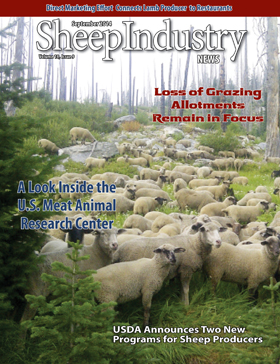Three Appointed to NSIIC Board
U.S. Department of Agriculture (USDA) Secretary Tom Vilsack has appointed three members to the National Sheep Industry Improvement Center (NSIIC) board of directors. Members will serve a three-year term of office beginning January 2015.
Appointed to the board representing sheep and goat producers are Linda Campbell of Luray, Va., and Laurie Hubbard of Huntington Mills, Penn. Appointed to the board representing expertise in marketing is Cody Heimke of Stroughton, Wisc.
Burlington Launches Merino FX
Burlington, a division of International Textile Group (ITG), has introduced the Merino FX collection of seasonless performance fabrics targeted to outdoor apparel. The collection includes a variety of 100-percent merino wool and merino-blend fabrics in different weights and constructions and advanced performance levels.
Noting that merino wool is often not regarded as a year-round fiber, Burlington Product Development Manager Tom Aubrey said, “The very thing that makes wool warm in winter makes it cool in summer, and the natural give and elasticity of wool fibers yields to the body’s movement.”
APHIS Sheep Priorities Outlined in Plan
The U.S. Department of Agriculture’s Animal and Plant Health Inspection Service’s (APHIS) Veterinary Services (VS) has developed five-year business plans to outline the priorities, objectives, strategies and field activities for each of the animal commodity groups in the VS budget line items – including sheep.
The overall objective of the sheep health program includes a handful of core objectives:
Eradicate classical scrapie from the United States.
Conduct comprehensive disease surveillance in sheep.
Conduct foreign and emerging disease threat and disaster planning and response.
Conduct zoonotic disease prevention and response.
Support the viability of the sheep industry.
Meat’s Future: More Lambs and Goats
Sheep and goat producers can take advantage of a situation where the world population rises, meat production drops and beef prices go up – making lamb and goat prices more competitive.
This was a scenario described to livestock scientists during the Joint Annual Meeting of the American Society of Animal Science, the American Dairy Science Association and the Canadian Society of Animal Science held in Kansas City in August.
The conference centered on meeting the expected global demands of 2050, said David Fernandez, Cooperative Extension Program livestock specialist at the University of Arkansas at Pine Bluff.
The world’s population is predicted to reach 9 billion by 2050; about 60 percent more food will be needed. Meat consumption is expected to rise as the world’s population becomes wealthier. China is expected to lead the change in the demand for meat.


